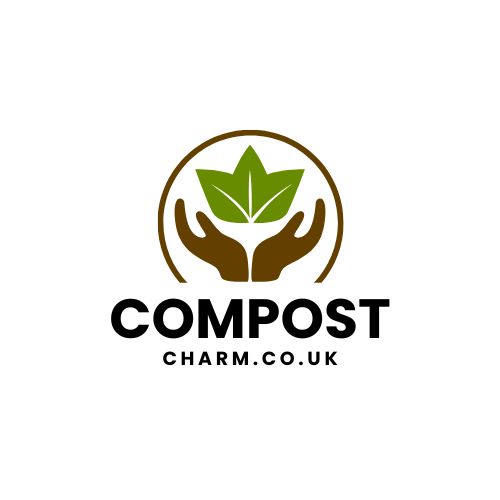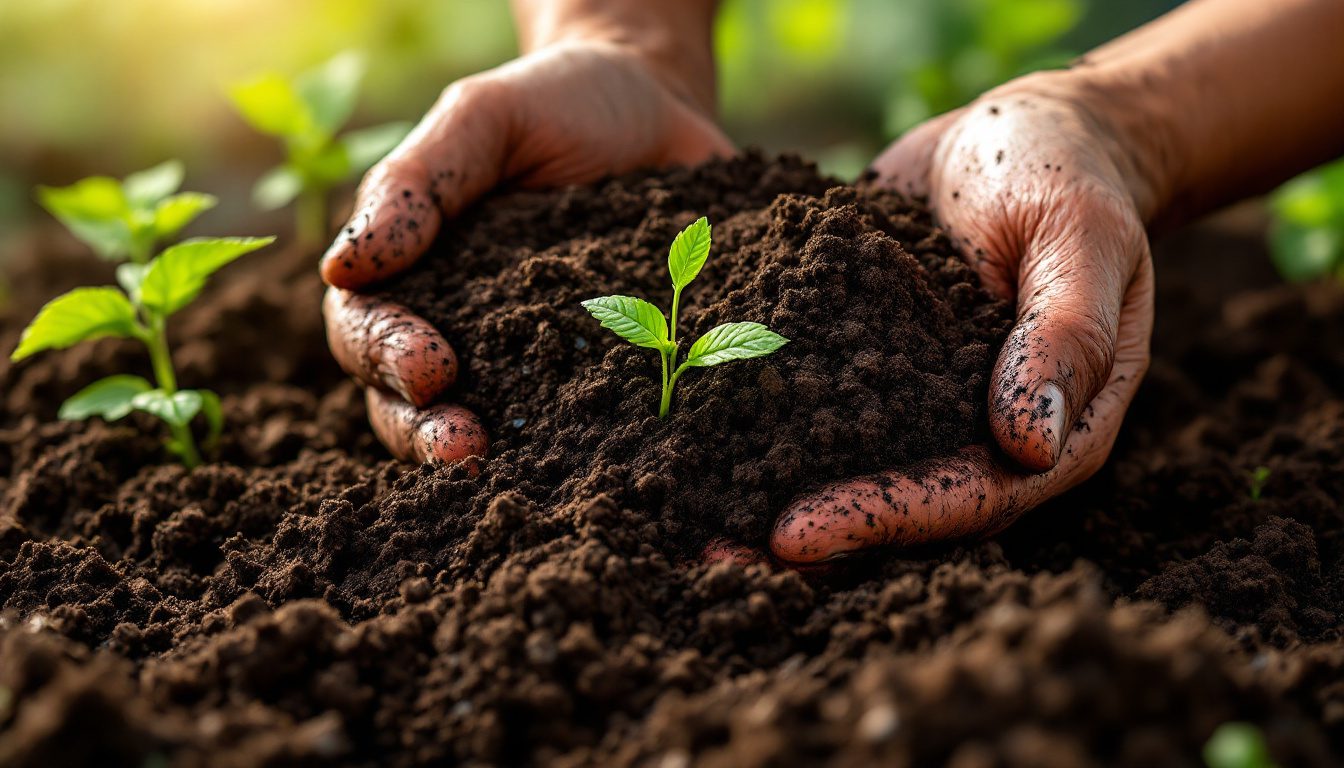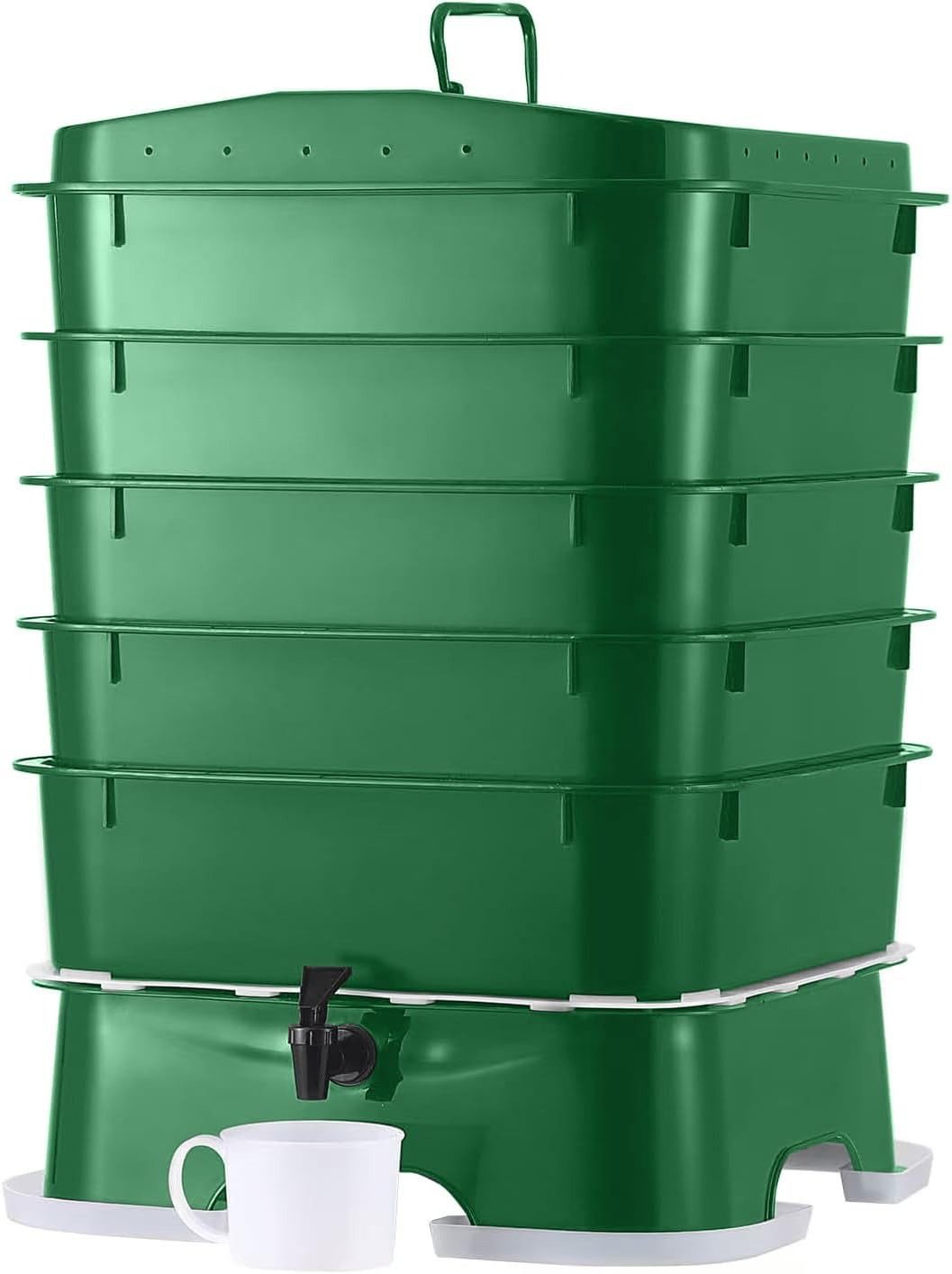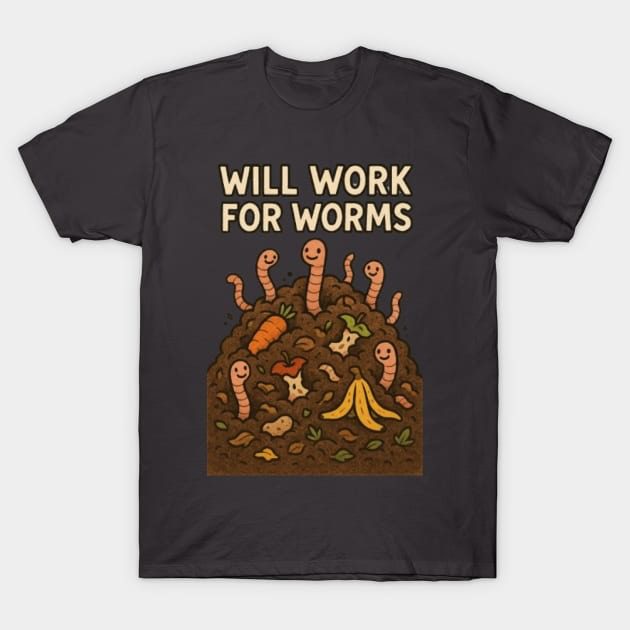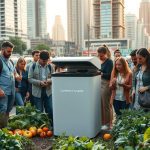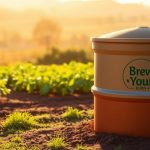Easy Tips for Healthier Gardens
Discover how using compost to improve soil boosts plant health, keeps gardens rich, and supports eco-friendly gardening with simple steps anyone can follow.
Welcome! If you want to make your garden soil healthier while cutting down on kitchen scraps and yard waste, you’re in the right place.
Using compost to improve soil is simple: composting is the process of turning everyday food leftovers and green waste into a dark, crumbly material your plants will love.
It matters because compost enriches soil, boosts moisture, and supports the tiny creatures that help roots grow strong, all while reducing landfill waste and helping the planet.
Composting at home is easier than ever. With tools like a compost tumbler or a tidy vermicomposting bin (that just means using worms to break it down), anyone can start—even beginners.
If you’ve ever wondered how to recycle more or create super-soil without lots of fuss, this guide is packed with practical tips to get you going.
Here’s what you’ll find inside:
- Clear steps for using compost to improve soil, at any skill level.
- Ideas for compost tumblers and vermicomposting to speed things up.
- Easy ways to recycle food and garden scraps so nothing goes to waste.
- Tips for home composting that really work, whether you have a small yard or a large garden.
Ready to get started? For even more beginner guidance, check out this handy guide to starting composting at home.
In the end, you’ll know how to make and use compost to nurture better soil—good for your plants, your wallet, and the earth!
What Is Composting and How Does It Improve Soil?
Imagine your kitchen scraps and garden trimmings turning into fluffy, rich earth that makes every plant in your garden happier.
That’s composting—a natural way to recycle your organic waste and boost soil health, whether you use a simple pile, a sleek compost tumbler, or a cozy worm bin.
Using compost to improve soil isn’t just a smart move for the environment; it’s like giving your soil a refreshing energy drink that helps everything thrive.
Composting: Turning Waste Into Soil Power
Composting is the process where organic materials like food scraps, coffee grounds, and autumn leaves break down with a little help from helpful microbes, fungi, and sometimes worms.
The result is compost, a crumbly, brown material loaded with nutrients. Why does this matter?
Simple—compost acts as a slow-release fertiliser, delivers micronutrients, and hosts millions of beneficial tiny organisms.
When you add compost to your soil, it’s like inviting a lively festival of microbes, worms, and bugs.
They all pitch in to break down nutrients, loosen heavy soils, and hold onto water that roots can use later.
Even if you’re new to the concept, composting is easy to start and incredibly rewarding for home gardeners and allotment keepers alike.
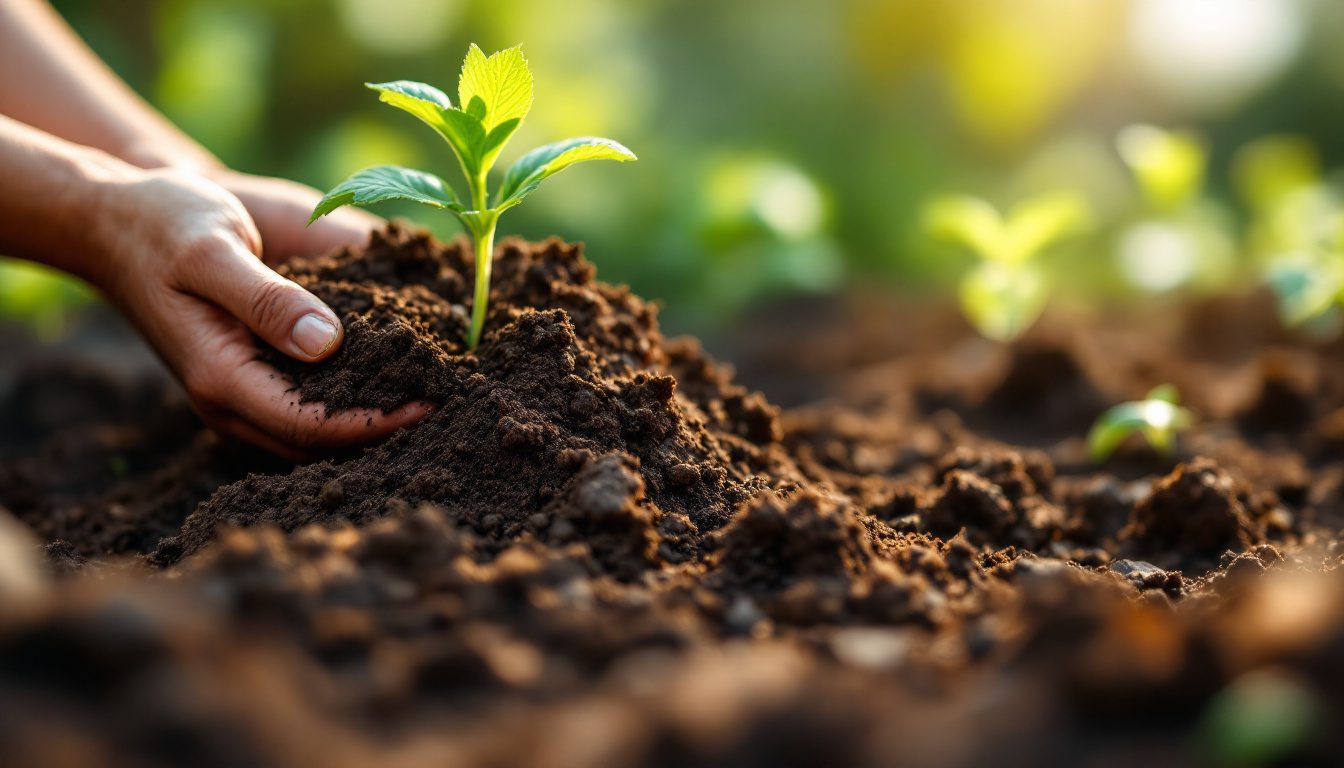
How Composting Boosts Soil Health
Using compost to improve soil goes far beyond just feeding plants. Here’s how it works its magic:
- Improves Soil Structure: Compost opens up clay soils, helping air and water flow. It also gives sandy soils more “body”, so moisture doesn’t drain away as quickly.
- Boosts Water Retention: Compost acts like a sponge. It holds on to water in dry spells and lets excess drain away when it’s wet.
- Feeds Soil Life: Healthy soil teems with beneficial bacteria, fungi, insects, and worms. Compost is their favourite meal, helping create a balanced, living ecosystem underground.
- Balances Nutrients: Compost slowly releases nitrogen, phosphorus, potassium, and trace minerals. Plants take what they need, so there’s less risk of “burning” them like with some synthetic fertilisers.
- Reduces Disease Risk: A healthy, living soil with lots of compost is naturally disease-resistant because the good bugs crowd out the bad.
You don’t have to be a scientist to see results. Regularly adding compost, whether homemade or from a bag, transforms dull, tired dirt into black gold.
Vermicomposting: Worms on the Job
Vermicomposting puts worms to work in your composting set-up. Red wigglers (a type of worm) gobble up kitchen scraps, turning them into worm castings—a fine, nutrient-rich material sometimes called “worm poo tea” for your plants.
This form of composting is perfect for flats, small gardens, and anyone short on space.
A big advantage of vermicomposting is how fast it works.
With the help of your worm cast, you’ll notice plants growing stronger and soil becoming softer and fluffier, even after just one season.
Curious about all the ways you can compost at home? Check out these easy 6 effective composting methods for practical ideas to suit every space and budget.
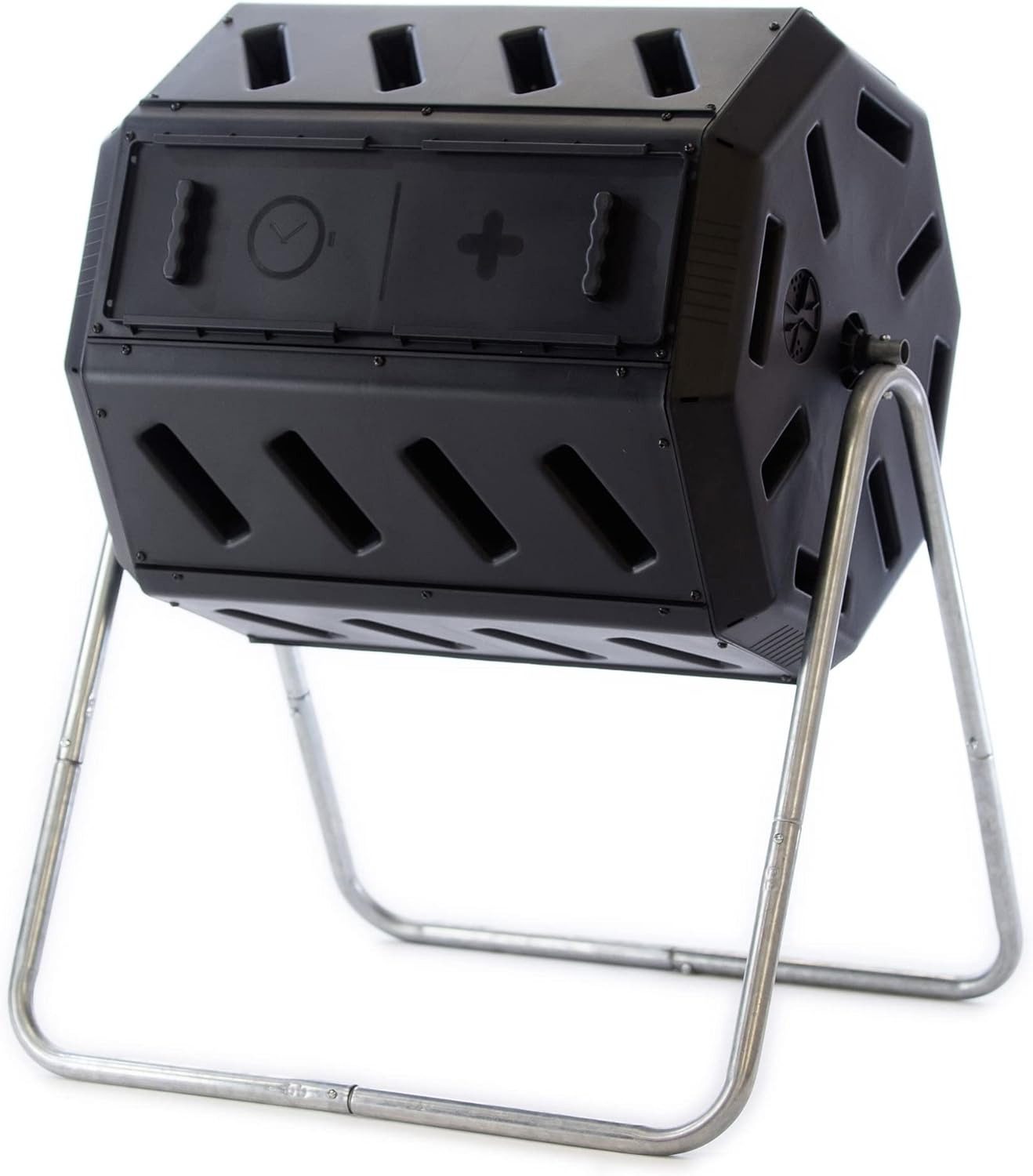
Compost Tumblers: Mix and Go
If you want a neat, mess-free system, a compost tumbler is your friend. This sealed drum makes turning your pile easy—just give it a spin! Better airflow means quicker breakdown and fewer pests.
Compost tumblers fit well in smaller gardens or patios and offer a clean look with little maintenance.
They’re also perfect for first-timers because you don’t need to dig, turn a heavy pile, or worry about animals getting in.
Fill your tumbler with greens and browns, turn it every few days, and you’ll soon have finished compost ready for action.
Not sure how to time your composting routine? Get the best tips for every season with this handy composting calendar for a thriving bin.
Quick Comparison: Soil Health With vs Without Compost
Here’s an easy table to show the difference compost makes:
| Soil Feature | With Compost | Without Compost |
|---|---|---|
| Structure | Fluffy, well-drained | Hard, compacted |
| Water Retention | Holds moisture well | Dries out quickly |
| Plant Growth | Strong, steady | Weak, inconsistent |
| Nutrient Supply | Balanced & slow-release | Often low or imbalanced |
| Pest & Disease Risk | Less likely | More likely |
Key Takeaways
- Composting recycles food and yard waste into valuable compost, reducing landfill waste.
- Compost makes soil richer, helps it hold water, and supports healthy plant growth.
- Vermicomposting uses worms for quicker results and richer compost.
- A compost tumbler is an easy, clean way to start if you want quick, odour-free compost.
- Regular use of compost improves soil health for gardens, allotments, and potted plants.
For more hands-on advice or questions, our instant composting FAQ bot is available to help guide your next steps.
Want to reduce waste at the source? Check out the practical ideas from the Don’t Toss It Campaign for real-life solutions.
Ready to watch your garden soil come alive? Compost is your ticket to healthier, stronger, and more fruitful plants.
Getting Started: Making Compost at Home
Getting started with composting is often simpler than it seems. The first step is choosing the right container or tool for your space and goals.
Whether you’re after neatness, speed, or just a fun family project, there’s a composting option for every home.
Let’s look at the most popular composting tools—compost tumblers, bins, and worm (vermicomposting) bins—and see how they stack up.
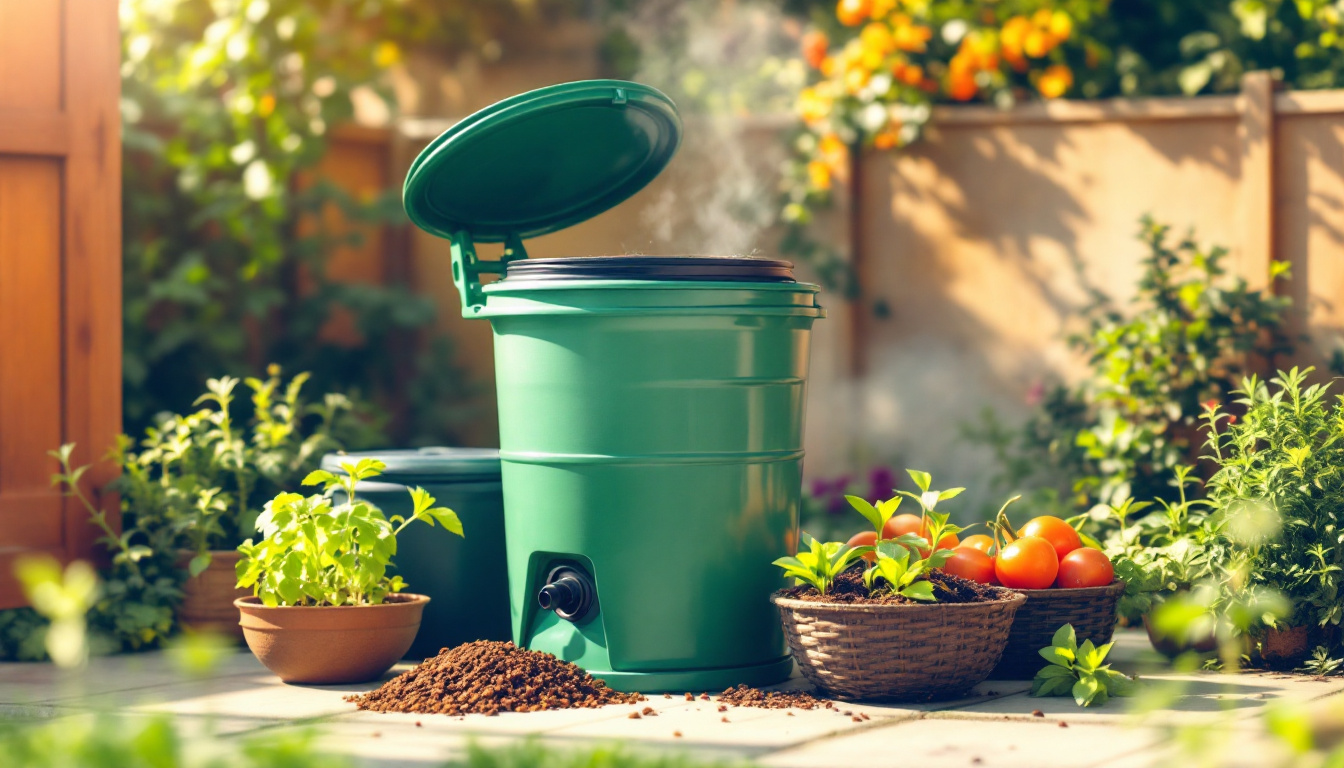
Common Composting Tools: Tumblers, Bins, and Worm Bins
Choosing the best container helps make using compost to improve soil easy, tidy, and fast.
Here’s how the main options compare:
Compost Tumblers: Quick and Tidy
A compost tumbler is a sealed drum that sits on a frame, letting you “spin” your compost to aerate it.
You just fill it with greens (like veg peelings) and browns (like dry leaves), latch the door, and give it a turn every few days.
This design keeps pests out, reduces smells, and speeds up breakdown.
Why choose a tumbler?
- Great for small spaces like patios, courtyards, or even large balconies.
- Very easy to turn—no need to dig or lift heavy piles.
- Fast results: Many tumblers make compost in as little as 4 to 8 weeks.
- Cleaner and more contained than open bins.
Families and beginners love compost tumblers because they’re simple and make regular mixing a breeze. If you want speedy, odour-free compost without much mess, a tumbler is your best friend.
If you want to see step-by-step guides and helpful reviews, check out this practical How to Make Compost using Tumblers & Bins.
For a seasonal plan on what to add and when, have a peek at the Composting Calendar Tips from Compost Charm.
Bins: Flexible and Classic
Compost bins are sturdy containers (sometimes just a wooden frame or a reusable plastic bin) that sit right on the ground.
They come in many shapes and sizes. You layer your scraps and clippings, mix every so often, and let the natural breakdown do its work.
What makes bins special?
- Perfect for larger gardens and if you have plenty of green waste.
- Flexible: You can build your own or buy ready-made models.
- Capacity: Bins hold more than tumblers, handling grass clippings, leaves, veg peelings, and small branches.
Bins suit those with a bit more outdoor space and anyone happy to let compost quietly mature for several months.
They require a little mixing and work best tucked away in a shady patch.
To brush up on classic bin composting, see expert tips at Composting At Home | US EPA, and get inspired to start composting with family using guides from Compost Charm.
Worm Bins (Vermicomposting): Rich Compost Indoors or Out
Vermicomposting bins use red worm species (like red wigglers) to turn kitchen scraps into worm castings.
These are packed with nutrients and great for containers and garden beds. Worm bins are compact, work indoors or outdoors, and—when well managed—have little to no smell.
Why go for vermicomposting?
- Fits in tight spots—flat, balcony, or under the sink.
- Quick results: Worms can turn waste into usable compost in a few weeks.
- Super nutrient-rich output—often used straight in pots or for seedlings.
- Fun for families curious about nature and science.
Vermicomposting is your best bet for year-round composting without a garden. It’s a smart choice for anyone wanting to cut waste inside the home.
For a step-by-step beginner guide to worm composting, see Vermicomposting For Beginners – Uncle Jim’s Guide.
At-a-Glance Comparison
| Tool | Best For | Speed | Space Needed | Family Friendly |
|---|---|---|---|---|
| Tumbler | Small gardens, patios | Fast | Compact | Yes |
| Bin | Larger gardens, flexibility | Slow-Moderate | Medium-Large | Yes |
| Worm Bin | Indoors, small spaces | Fast | Very compact | Yes (very) |
No matter which tool you choose, using compost to improve soil means you’ll be giving your plants stronger roots, better water retention, and a steady supply of nutrients.
The most important part? Start with what suits your space and routine best, then enjoy the process of turning waste into something wonderful.
Key Takeaways:
- Compost tumblers make neat, fast compost with little effort—perfect for small gardens.
- Traditional bins offer volume and flexibility for those with more space or yard waste.
- Worm bins deliver quick, rich compost even indoors, great for small homes or curious beginners.
- The best container is the one you’ll use—pick what fits your lifestyle and space.
To learn more about composting setups, see the full How to Make Compost using Tumblers & Bins guide or explore Compost Charm’s Composting Calendar Tips for year-round success.
How to Use Compost for Healthier Soil
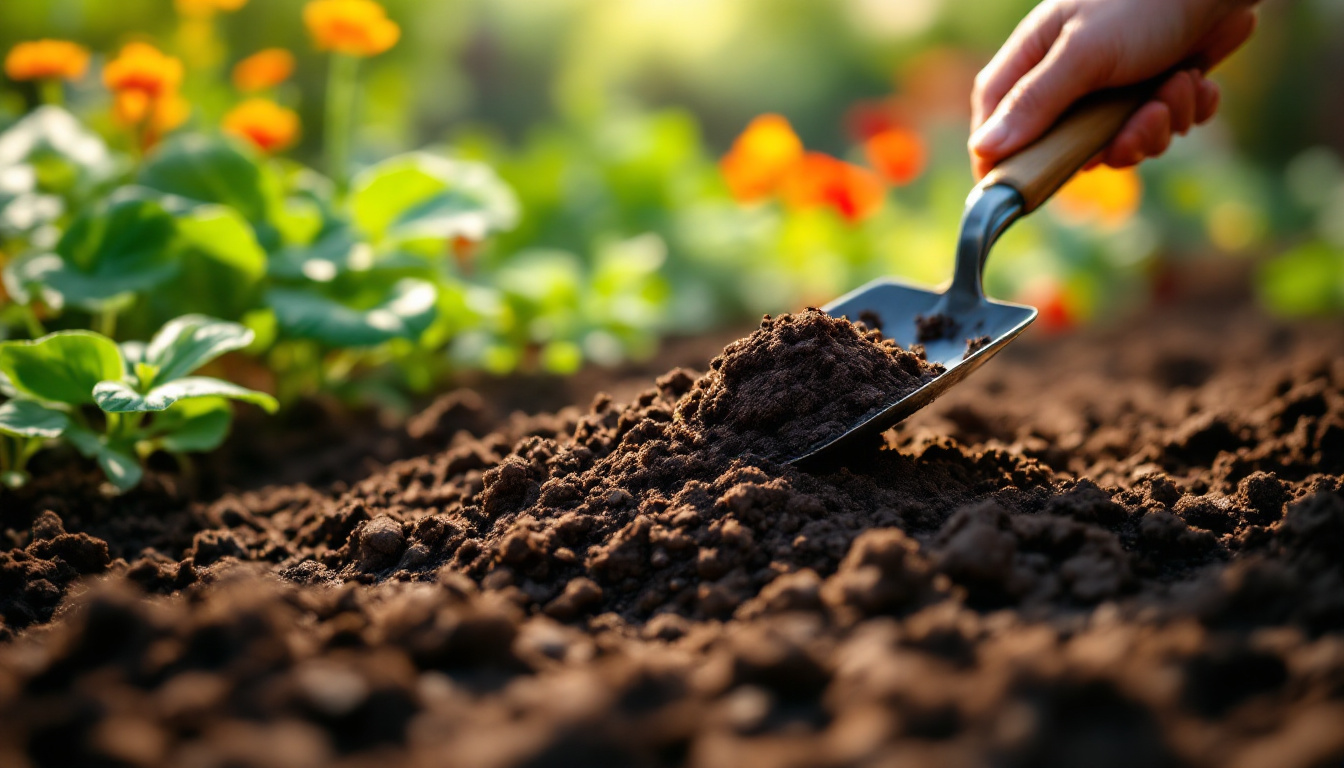
Using compost to improve soil unlocks a world of benefits for any garden or allotment.
Whether you’re just getting started or looking to get the most out of your homemade mix, knowing how to use your compost is key to stronger plants and soil that feels alive.
Here’s how you can make the most of your efforts, handle common beginner problems, and keep your composting journey pleasant and successful.
Troubleshooting Tips for New Composters
Even the best composters run into a few bumps along the way.
If your compost pile isn’t breaking down the way you hoped, don’t worry. Most problems are simple to fix once you spot them.
Here’s a look at the most common composting issues and how to fix them fast:
Smelly Compost: Like Rotten Eggs or Ammonia
A strong stink usually means your pile has too much moisture or not enough air.
Think of over-watering houseplants or shutting a wardrobe with no ventilation—it’s a recipe for a sour smell.
Quick fix:
- Fluff the pile with a garden fork to add air.
- Add dry “browns” like straw, dry leaves, or shredded cardboard.
- Avoid putting in meat, dairy, or oily foods.
Pesky Pests: Flies, Ants, or Uneaten Scraps
Nobody wants to open their compost tumbler or bin and find a bug party.
Pests are mostly attracted by food scraps sitting on top or the wrong types of items tossed in.
Quick fix:
- Bury new kitchen scraps deep within the pile instead of leaving them exposed.
- Don’t add bread, meats, or cooked foods.
- Make sure the bin or tumbler closes securely.
Too Wet or Soggy Piles
A compost pile that looks like sludge needs more balance.
Too much water can sometimes result from lots of fresh greens (like veg peelings), too much rain, or poor drainage.
Quick fix:
- Mix in dry browns (leaves, cardboard, sawdust) until the pile feels like a wrung-out sponge.
- Turn the pile more often for better airflow.
- If your pile is uncovered and outside, add a tarp in heavy rain.
Too Dry or Slow to Break Down
Dry compost won’t turn into that black, crumbly stuff you want. If it looks dusty and nothing’s breaking down, your pile is thirsty!
Quick fix:
- Sprinkle water over the pile as you mix it—just enough to feel damp, not soaked.
- Add more green waste (like grass clippings or fruit peels) to balance it out.
- Cover outdoor piles to stop evaporation on hot days.
Table: Quick Compost Problem Solver
| Problem | Signs | Solution |
|---|---|---|
| Smelly pile | Rotten egg/ammonia smell | Add dry browns, turn for air |
| Pests | Flies, ants, scraps on top | Bury food, avoid meat/dairy |
| Too wet | Soggy, slimy, slow to break down | Add browns, turn, cover if wet |
| Too dry | Dusty, little change | Sprinkle water, add more greens |
Composting isn’t one-size-fits-all. Don’t let small setbacks put you off. Most issues can be solved with simple tweaks, and each batch teaches you something new about your mix and your soil.
If you feel stuck, you always have backup: get instant help for composting questions for practical, friendly support in real time.
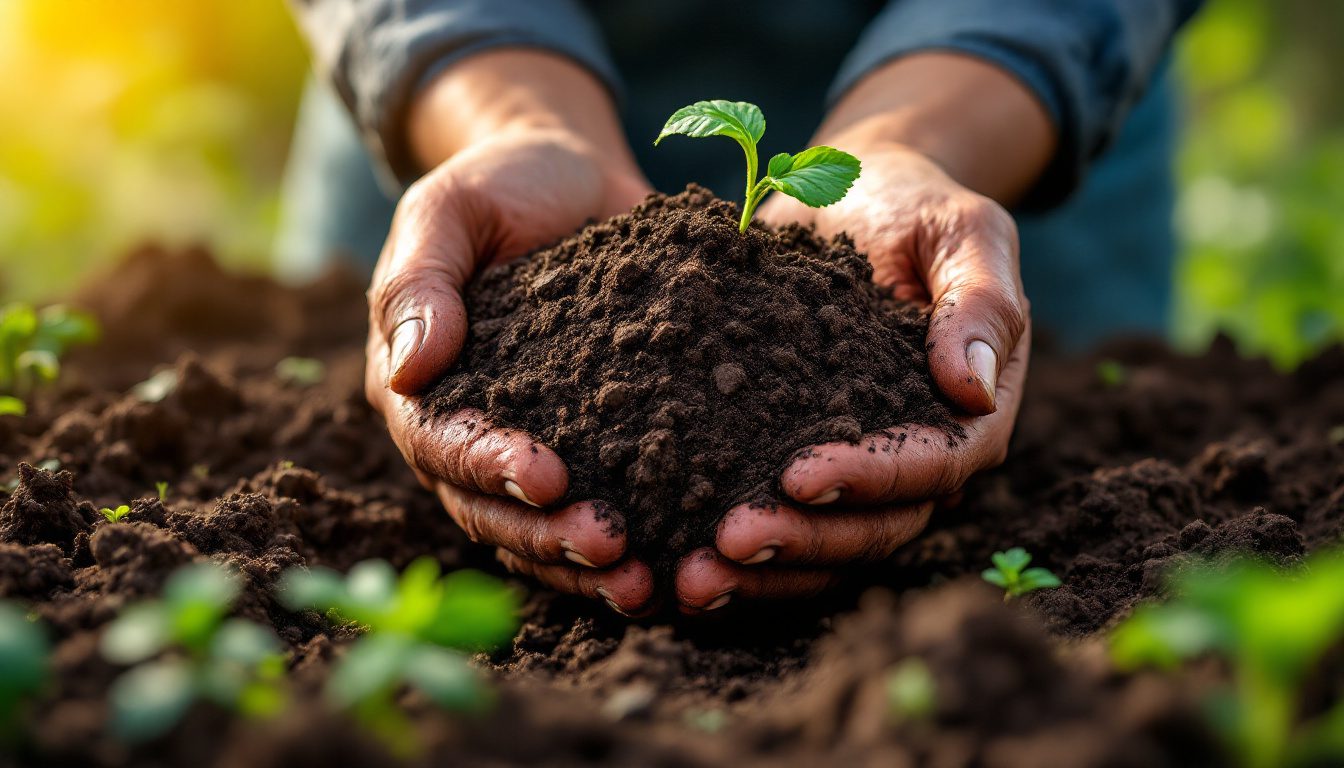
Key Takeaways
- Smelly compost means not enough air or too much water—add browns and mix it up.
- Pests hang around when scraps are left on top or wrong foods are used—bury and avoid animal products.
- A wet pile needs more dry browns (like leaves or cardboard) and some turning.
- A dry pile wants a sprinkle of water and more green scraps.
- Composting is easy to troubleshoot—don’t let small setbacks spoil the fun.
- Using compost to improve soil is one of the best ways to feed your plants, keep waste out of landfill, and grow a healthier, more beautiful garden.
Ready to get your pile back on track or start a new one? Dive into a detailed step-by-step kitchen waste composting guide to make home composting smooth and sustainable.
Every garden, big or small, can benefit from this simple “waste to soil” magic.
Living Sustainably: The Impact of Composting
Living a little greener doesn’t mean you need to start big. Sometimes, all it takes is putting your kitchen scraps and garden waste to work.
Composting is one of the smartest habits for turning “waste” into something genuinely good for your garden, your community, and the planet.
Let’s explore how using compost to improve soil makes life easier for gardeners and richer for the earth.
 Photo by Letícia Alvares
Photo by Letícia Alvares
Why Composting Matters for Soil and Sustainability
Composting is simple: it turns everyday food peelings, coffee grounds, grass clippings, and fallen leaves into dark, rich compost.
This finished compost is more than garden soil—it’s packed with nutrients, boosts soil life, and helps everything grow stronger.
When you compost at home, you recycle natural waste and get healthier plants, all at once.
The beauty of using compost to improve soil is that it solves two problems: less rubbish sent to landfill and better, more vibrant soil wherever you spread it.
The magic comes from tiny helpers—microbes and worms—breaking down scraps into food for your next generation of flowers and veggies.
Wondering about the local benefits of compost? See how easy it is to support your own patch by checking out tips on how composting boosts local soil health.
How Using Compost to Improve Soil Helps the Planet
Every banana peel, tea bag, or faded lettuce leaf that goes into your compost bin skips a trip to landfill.
Like using leftovers for a tasty soup, composting finds a purpose for nearly everything in your kitchen and garden.
This cuts methane gas—a big player in climate change—from wastes buried in the ground.
Here’s what makes home composting so valuable for both your garden and the wider world:
- Cuts down rubbish: Less waste in bins, less stress on landfills.
- Reduces greenhouse gases: Composting breaks things down with air, not buried away, so it avoids the methane gas landfills make.
- Boosts water saving: Compost-rich soil holds water, helping during UK dry spells and making gardens more drought friendly.
- Supports wildlife: Compost feeds worms, beetles, and soil microbes, building healthy habitats from the ground up.
Composting Methods for Every Home
You don’t need country acres or heaps of time to start composting.
Whether you use a compact compost tumbler on a city patio, keep a worm bin under the sink (that’s vermicomposting), or build a big open heap, there’s a method for every lifestyle.
Let’s break down the practical methods:
- Compost tumblers: Clean, fast, and tidy, making them ideal for families and patios.
- Traditional heaps or bins: Best for gardens with space; easy to scale up.
- Vermicomposting: Uses friendly worms to eat through the mess quicker, making great compost for pots or raised beds.
Families who want extra tips on composting tools or setups can discover the advantages of home composting for solutions that fit all spaces.
What Changes When You Use Compost?
The real magic of using compost to improve soil is in the results you see and feel:
| Soil Quality | Before Composting | After Composting |
|---|---|---|
| Texture | Hard or crumbly | Softer, holds together |
| Water Handling | Puddles or dries fast | Absorbs, drains, stays moist |
| Worm Activity | Few worms, insects | Full of life below ground |
| Plant Growth | Struggles, patchy | Greener, stronger |
| Waste Output | Bins fill up quick | Less landfill rubbish |
Adding compost does a lot for your garden beds, vegetable patches, and even lawns.
For those keen to see specific lawn benefits, learn more about the effect of compost on lawn growth for supercharged grass.
The Ripple Effect: Compost Creates Community
One compost pile might not seem like much, but it sets off a ripple effect. Composting encourages kids to recycle, brings neighbors together at community gardens, and inspires families to find new ways to waste less.
Many schools and councils now team up to collect food waste for compost projects.
Together, those small habits help cities and towns keep precious soil in better shape for years to come.
Using compost to improve soil also answers a bigger need—healthy, living soil is the secret behind good food, clean water, and safe homes for insects and birds.
The Soil Association shares even more research on why compost is good news for soil health if you want to dig a bit deeper.
Key Takeaways
- Composting at home is one of the easiest ways to recycle and support the environment.
- Using compost to improve soil benefits both gardens and wildlife, reducing the need for chemicals.
- You can compost in almost any space—tumblers, worm bins, or open heaps all do the job.
- Adding compost turns poor soil into rich, living earth, making every planting a success.
- Small backyard composting efforts ripple out to healthier local communities and a greener planet.
Ready to start or want to troubleshoot your setup?
Explore the handy composting FAQ bot for instant advice on anything from vermicomposting to getting your compost tumbler spinning just right.
Get this great design from our Compost Teepublic Shop!
Conclusion
Using compost to improve soil transforms gardens, pots, and even balconies into healthier spaces for plants and people.
Composting is straightforward, easy to start, and helps the planet by reducing landfill waste.
Whether you use a classic pile, a compost tumbler, or give vermicomposting a go, each approach brings clear rewards.
Compost gives soil structure, feeds worms and microbes, and helps plants grow without harsh chemicals.
Key takeaways from this guide:
- Composting turns kitchen scraps and green waste into natural plant food.
- Good compost improves soil texture, keeps moisture in the ground, and reduces the need for fertilisers.
- Anyone can start with simple tools like compost tumblers or small worm bins.
- Vermicomposting is great for quick results or small indoor spaces.
- Regular compost use supports healthy gardens and a cleaner planet.
- Plenty of step-by-step guides and troubleshooting resources, like the composting FAQ bot, are available for extra help.
You don’t need to be an expert or have a huge garden. A handful of kitchen scraps and a little care can lead to rich, living soil.
For more ideas, check out tips on starting composting at home or discover which method fits your lifestyle best.
Thank you for reading!
If you’re ready to join the many others turning waste into something wonderful, give composting a try this season.
Share your questions, wins, or compost stories anytime.
Quick FAQ
What can go in my compost?
Compost loves fruit and veg scraps, coffee grounds, tea bags, eggshells, grass clippings, and dry leaves. Skip meat, dairy, and oily foods, as these cause smells and pests.
How long does it take to make compost?
Compost can be ready in 1-3 months in a compost tumbler, or up to a year in a regular garden bin. Vermicomposting often finishes even faster.
Is composting messy?
Composting is tidy when you balance green and brown materials. Compost tumblers and worm bins control smells and keep things clean.
What is vermicomposting?
Vermicomposting uses worms to break down food scraps quickly. Worm castings are nutrient-rich and great for plants.
Do compost tumblers work well?
Yes, compost tumblers are convenient, speed up composting, and keep pests out. They’re perfect for patios or anyone short on space.
Curious about which composting method suits you best?
Explore 6 effective composting methods for easy-to-follow options. Happy composting!
